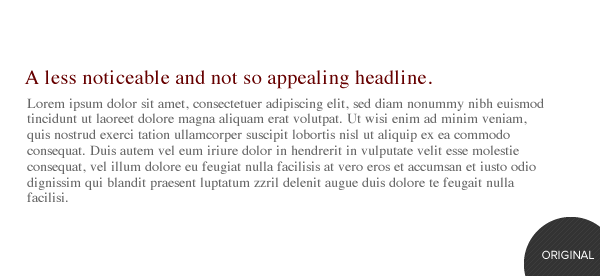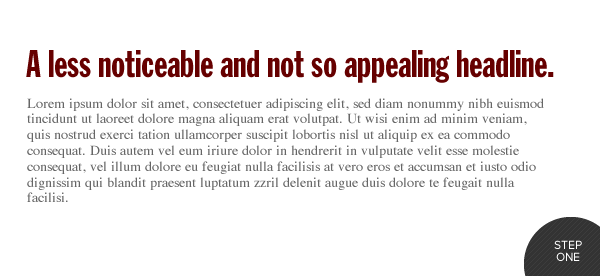 It’s not uncommon for a designer in today’s world to pay little attention to how type is laid out, especially with the ever-so-convenient default settings of heading tags and web safe fonts found universally on the web.
If we as interactive designers we’re able to take a little more time when it came to typography, than the results would show a unique, well thought of design as oppose to a “run of the mill” creation.
There is a good chance that the majority of designers and designs you admire showcase good examples of typography.
I’ll show you a few steps I take in tweaking set type to be more appealing than those default scenarios of 24px H1 tags along with 13px set in Times New Roman.
It’s not uncommon for a designer in today’s world to pay little attention to how type is laid out, especially with the ever-so-convenient default settings of heading tags and web safe fonts found universally on the web.
If we as interactive designers we’re able to take a little more time when it came to typography, than the results would show a unique, well thought of design as oppose to a “run of the mill” creation.
There is a good chance that the majority of designers and designs you admire showcase good examples of typography.
I’ll show you a few steps I take in tweaking set type to be more appealing than those default scenarios of 24px H1 tags along with 13px set in Times New Roman.

Don't settle for default settings, everyone is doing it.
Here we have the ever- so- common look of a heading along with a chunk of body copy to follow. This doesn’t exactly pull you in or set itself apart from all the other samples just like it, right? So to make the text sample more visually appealing, first, we’re going to make a few changes with our font selection.
Choose a font that will have more visual weight with your headline
Although font selection is not exactly “typography,” it is in fact a quintessential component to help the type on a page distinguish itself from other elements. With the onset of @font-face, massive amounts of choices are available to designers anywhere. Here I’ve used an Extra Condensed Gothic Style font that can easily be found on a free font site like FontSquirrel.com. If we stop and think about it, the name “Condensed” should mean something, because it is in fact more dense than it’s normal book style family member, which is exactly what we want out of a headline:, something that pulls the user in and truly sets itself apart from the body copy. It certainly succeeds in grabbing your attention better than the original but there are a few things we could do to further improve the text.
Make it more appealing with two lines of CSS
The immediate change is in the letters; they’re all capitalized now but they also now have negative kerning between each of the letters (a technique carried over from newspaper design). Both of these characteristics can easily be accomplished through CSS, {text-transform:uppercase; and letter-spacing:-Xpx;}. By making these two lines worth of coding changes, it results in a major improvement in visual weight, especially over the original .
Work out any last little tweaks
In the next step, the font used in the body paragraph has in fact changed to a cleaner sans-serif, which better compliments the headline text. We’re getting closer to a much more visually appealing design, but there are a few changes we can make to clean it up even more. As the green indicators show, there are unequal margins and what typographers like to call an “orphan.” Which is a single word that falls to the last line of the paragraph. It creates a very unequal weight visually as compared to the rest of the text, and this issue can be solved easily by rewording the text slightly. When it comes to margins, there is no rule that all must be equal. However, if you are starting a young web design career, it’s good practice to have equal margins throughout until you experience and learn techniques that allow you to extend beyond the guidelines of typesetting and still accomplish your goal visually. After creating a more balanced visual canvas by removing the orphan and adjusting the margins you can see the end result, a well set type sample that’s comfortable where it lays.
What are your best tips for web typography? Let us know in the comments!
After creating a more balanced visual canvas by removing the orphan and adjusting the margins you can see the end result, a well set type sample that’s comfortable where it lays.
What are your best tips for web typography? Let us know in the comments!Dallas
Dallas is an Interactive Designer at 352 Media Group, a digital marketing and web design company.
Read Next
3 Essential Design Trends, November 2024
Touchable texture, distinct grids, and two-column designs are some of the most trending website design elements of…
20 Best New Websites, October 2024
Something we’re seeing more and more of is the ‘customizable’ site. Most often, this means a button to swap between…
Exciting New Tools for Designers, October 2024
We’ve got goodies for designers, developers, SEO-ers, content managers, and those of you who wear multiple hats. And,…
15 Best New Fonts, September 2024
Welcome to our roundup of the best new fonts we’ve found on the web in the previous four weeks. In this month’s edition…
By Simon Sterne
3 Essential Design Trends, October 2024
This article is brought to you by Constantino, a renowned company offering premium and affordable website design
You…
A Beginner’s Guide to Using BlueSky for Business Success
In today’s fast-paced digital world, businesses are always on the lookout for new ways to connect with their audience.…
By Louise North
The Importance of Title Tags: Tips and Tricks to Optimize for SEO
When it comes to on-page SEO, there’s one element that plays a pivotal role in both search engine rankings and user…
By Simon Sterne
20 Best New Websites, September 2024
We have a mixed bag for you with both minimalist and maximalist designs, and single pagers alongside much bigger, but…
Exciting New Tools for Designers, September 2024
This time around we are aiming to simplify life, with some light and fast analytics, an all-in-one productivity…
3 Essential Design Trends, September 2024
September's web design trends have a fun, fall feeling ... and we love it. See what's trending in website design this…
Crafting Personalized Experiences with AI
Picture this: You open Netflix, and it’s like the platform just knows what you’re in the mood for. Or maybe you’re…
By Simon Sterne
15 Best New Fonts, August 2024
Welcome to August’s roundup of the best fonts we’ve found over the last few weeks. 2024’s trend for flowing curves and…
By Ben Moss















